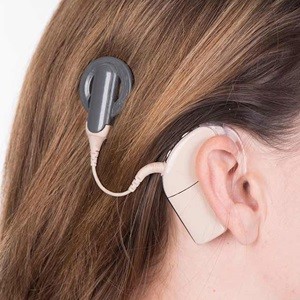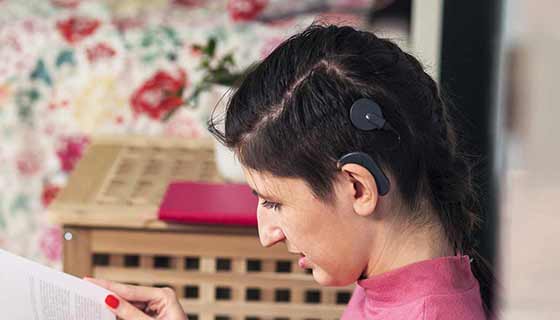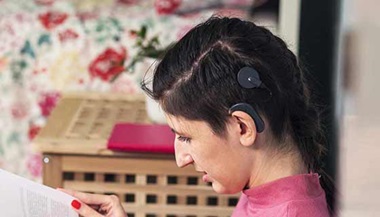Cochlear Implant Surgery and Rehabilitation
Featured Expert:
Surgery to place a cochlear implant inside the ear is an outpatient procedure performed in a hospital or clinic, using general anesthesia. The patient returns to the audiologist a few weeks later to have the cochlear implant activated and programmed (mapped).
What You Need to Know
- A cochlear implant, which is a small electronic device, may be an option when hearing aids do not provide the clarity of sound needed to understand speech and spoken language.
- Early intervention is key. Opportunity for improvement decreases over time as hearing loss worsens. This is especially true for children — an implant may have more benefit the sooner it is provided for a child.
- Rehabilitation and training after surgery are required in order to achieve the best possible hearing ability.
What happens during cochlear implant surgery?
Cochlear implant surgery takes place in a hospital or clinic. The surgery lasts about two hours. Patients are given medication (general anesthesia) so that they are asleep during the procedure.
- The surgeon makes a small incision behind the ear and then creates an opening in the mastoid bone to guide the electrode to the cochlea.
- The implant electrodes are placed inside the cochlea.
- The surgeon places an internal processor in a pocket between the muscle and bone behind the ear. The internal processor receives information from an external speech processor that will be worn outside the skin.
- The incisions are then closed, and the patient is moved into the recovery area and watched closely as he or she recovers from the anesthesia.
The patient is discharged after several hours of observation and can go home to rest. Overall hearing will be different on the side of the implant right after surgery — the device will be programmed a few weeks later, allowing time to for the incisions to heal. During this time, you will not be able to use a hearing aid in the ear that had surgery.
Recovery After Cochlear Implant Surgery
Before leaving the hospital or surgery center, you are given instructions on how to care for the incisions, which may include:
- How to change dressings and care for stitches
- When to resume washing the area around the incision (usually a day or two after the surgery)
During a follow-up appointment, about one week after the surgery, the surgeon will inspect the incisions and remove stitches. Typically, it is recommended to wait three to four weeks for the area to heal before activating the cochlear implant.
Increased pain, swelling, drainage or fever should be reported to the doctor after the procedure.
Cochlear Implant Activation and Programming
When the inner ear has healed enough, you will return to the audiologist, who will program the cochlear implant and show you how to use the external processor on the ear. The goal is to get the nerves and brain used to hearing again.
A series of programming appointments takes place during a four-week to six-week period. During the early programming appointments, most people do not understand the sounds coming through the implant. You will work with your audiologist and auditory rehabilitation therapist to develop a plan to train the brain to interpret sounds in a way that fits with your lifestyle.
After that, programming appointments are needed every six to 12 months during the life of the implant. These visits help the care team assess the progress as the brain learns to process sounds and give them meaning. Adjustments are be made to the implant if necessary.
Cochlear Implantation Activation Process: Johns Hopkins Cochlear Implant Center | Q&A
Cochlear Implant Rehabilitation
While the cochlear implant provides access to sound, understanding takes more than just hearing. A good rehabilitation program develops the person’s ability to detect, imitate and associate meaning with the sounds of spoken language.
A cochlear implant rehabilitation team typically includes an audiologist, speech-language pathologists, educators of the deaf and other professionals. They work together to establish a path to success for each patient by providing instruction, with analysis and feedback, to help develop the best new hearing system using the cochlear implant. Encouragement and support from family members and friends gives people a strong advantage.
The rehabilitation program is different depending on your experience with hearing before the cochlear implant surgery:
- People who have never heard before may need intensive personalized rehabilitation.
- Those who are learning to hear again may have a program that focuses on helping them get the most out of using the devices.
The program also differs between children and adults:
Children who have had impaired hearing since birth will develop a language system with the new auditory signal provided by the cochlear implant, but adults must learn to attach meaning to their established language system. Rehabilitation and listening therapy for children begins shortly after the implant is activated. A typical schedule is one hour per week.
Rehabilitation for adults may begin with an initial consultation after at least one month of listening experience with the cochlear implant. The person’s needs for auditory therapy, communication management and the adjustment to an auditory environment are considered when developing the rehabilitation plan. Based on the results of this functional evaluation, the therapist will recommend a treatment plan for follow-up services that will occur weekly or as needed.
Both children and adults need immersion in an auditory-rich environment to reach their maximal potential with the cochlear implant.
Over several months after the surgery, the brain will learn to understand the implant stimulation patterns, enabling speech comprehension. As hearing becomes more sensitive, adjustments to the volume will help accommodate the changes.
The Johns Hopkins Cochlear Implant Center

The Cochlear Implant Center offers a comprehensive approach to cochlear implantation and rehabilitation, including one-on-one therapy to help patients learn to use cochlear implants. We perform hundreds of cochlear implant surgeries each year on adults and children, lead clinical trials and provide state-of-the-art care.
Risks and Complications of Cochlear Implant Surgery
Cochlear implant surgery is a safe procedure and complications are rare. However, as with all surgeries, there are risks. They include:
- Bleeding
- Swelling
- Infection around the implant
- Ringing in the ears (tinnitus)
- Dizziness and vertigo
- Numbness around the ear
- Changes in taste
- Dry mouth
- Injury to the facial nerve, which can cause movement problems in the face
- Leakage of spinal fluid
- Infection of the membrane that covers the brain (meningitis)
- Risks regarding general anesthesia
- Need to have the implant removed because of infection
There may be other risks, depending on the patient’s medical condition. It is important to discuss any concerns with the surgeon before the procedure.
Family Receives the Gift of Hearing

When Tracy and Josh Huegel’s children were born, each child had a 25 percent change of being deaf. Four of their five children were either born deaf or became deaf at an early age. As the director of the Johns Hopkins Cochlear Implant Center, Howard Francis, M.D., performed cochlear implantation surgery on each of the Huegel’s four deaf children.








